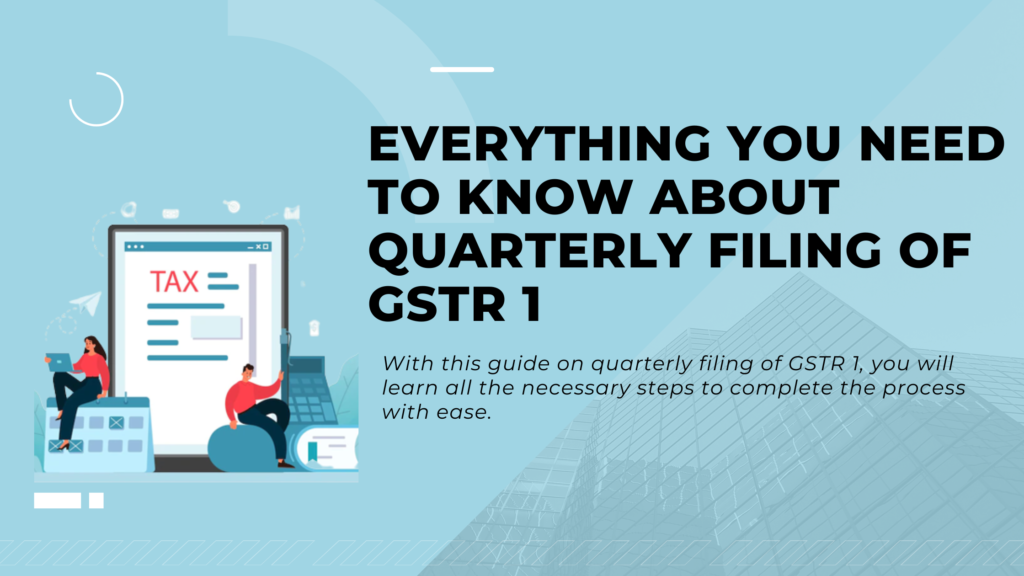Everything You Need to Know About Quarterly Filing of GSTR 1

quarterly filing of gstr 1
Goods and Services Tax (GST) was introduced in India in 2017 as a unified tax system to replace various indirect taxes. Since its implementation, businesses have had to undergo significant changes to ensure compliance with the new tax regime. One of the most significant changes brought about by GST is the requirement to file regular returns, which includes the quarterly filing of GSTR 1.
What is GSTR 1?
GSTR 1 is a monthly or quarterly return that provides details of all outward supplies made by registered taxpayers. It includes information on taxable supplies, exempt supplies, and exports made by a business. The GSTR 1 return has to be filed by all registered taxpayers, except for those who have opted for the composition scheme.
The quarterly filing of GSTR 1 is a recent development that was introduced to ease the compliance burden on small businesses. Prior to this, all taxpayers had to file GSTR 1 on a monthly basis. The quarterly filing of GSTR 1 applies only to taxpayers with a turnover of up to Rs. 5 crore.
How does quarterly filing of GSTR 1 work?
Under the quarterly filing of GSTR 1, registered taxpayers are required to file their returns once every three months, instead of on a monthly basis.
The following are the details that must be included in the quarterly filing of GSTR 1:
Basic details of the taxpayer: This includes the name of the taxpayer, the GSTIN number, and the period for which the return is being filed.
Outward supplies made to registered taxpayers: This section contains details of all supplies made to other registered taxpayers during the period, including details of the recipient, the invoice number, and the value of the supplies.
Outward supplies made to unregistered taxpayers: This section contains details of all supplies made to unregistered taxpayers during the period, including details of the recipient, the invoice number, and the value of the supplies.
Details of debit/credit notes issued during the period: This section contains details of all debit and credit notes issued by the taxpayer during the period.
HSN summary of outward supplies: This section contains a summary of all supplies made by the taxpayer, classified according to their Harmonised System of Nomenclature (HSN) code.
Documents issued during the period: This section contains details of all invoices, debit notes, and credit notes issued during the period.
Benefits of quarterly filing of GSTR 1
The introduction of the quarterly filing of GSTR 1 has several benefits for small businesses, including the following:
- Reduced compliance burden: The quarterly filing of GSTR 1 reduces the compliance burden on small businesses, as they no longer have to file monthly returns. This saves time and resources, allowing businesses to focus on their core operations.
- Increased ease of compliance: The quarterly filing of GSTR 1 simplifies the compliance process for small businesses, as it involves less paperwork and less frequent filing.
- Better cash flow management: It improves cash flow management for small businesses, as they can avoid paying taxes on a monthly basis.
- Better compliance rates: The quarterly filing of GSTR 1 is expected to improve compliance rates among small businesses, as they are more likely to file their returns on time when the filing frequency is reduced.
Challenges of quarterly filing of GSTR 1
Here are some points on the challenges of quarterly filing of GSTR 1:
Increased risk of errors: The quarterly filing of GSTR 1 increases the risk of errors, as businesses have to file returns covering a longer period of time.
Difficulty in tracking supplies: The delay between filing periods may make it challenging to track supplies, leading to the possibility of missing or inaccurate information.
Difficulty in availing input tax credit: The delay in filing returns may also make it difficult for businesses to avail input tax credit, as it requires matching the input tax credit claimed by the buyer with the output tax paid by the seller.
Difficulty in complying with other regulations: It may lead to difficulties in complying with other regulations, such as e-invoicing and e-way bill requirements, as they may require more frequent filings.
Increased compliance costs: Businesses may need to invest in additional resources to ensure compliance with the quarterly filing of GSTR 1, which may increase compliance costs.
Conclusion
In conclusion, the quarterly filing of GSTR 1 is a significant development in the GST compliance process in India. While it has several benefits, such as reducing the compliance burden for small businesses and improving cash flow management, it also presents some challenges, such as the increased risk of errors and difficulties in tracking supplies. It is essential for businesses to be aware of these challenges and take steps to ensure compliance with the new filing requirements. The government has made efforts to simplify the compliance process by introducing the quarterly filing GSTR 1 for small businesses, and it is important that businesses take advantage of these efforts to ensure smooth compliance with GST regulations. Overall, this quarterly filing is an important step towards simplifying the GST compliance process and promoting the ease of doing business in India.
Also Read: Revolutionizing TV: How Cloud-Based Broadcasting Software Can Deliver Fast Streaming
Also Read: How SEO, content marketing and social media marketing are linked


